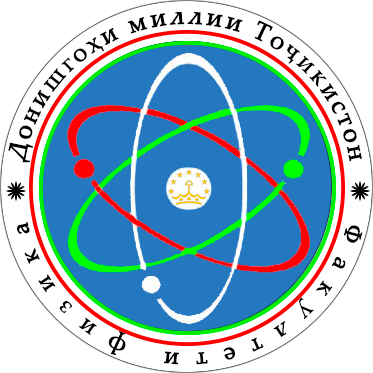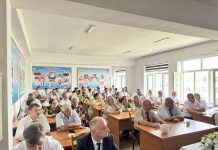(On the Occasion of the 90th Anniversary of Ustod Inom Bobodjanov)
On February 23, 2025, one of the founders of the Department of Nuclear Physics at the Faculty of Physics of the National University of Tajikistan, Inom Bobodjanov, will celebrate his 90th birthday. In this article, we will highlight only those moments of his biography that are directly related to the Department of Nuclear Physics.
In 1960, within the Department of Experimental Physics of the Faculty of Physics and Mathematics of the Tajik State University named after V.I. Lenin, a nuclear physics specialization was established, which became an independent department in 1962. It is important to note that in the Soviet Union, everything was carried out according to specific plans and necessities. This raises the question: why was there a need to establish a new department? In our opinion, the following factors led to the creation of the Department of Nuclear Physics:
- The training of specialists in atomic and nuclear physics, which was one of the fastest-growing fields of physics. Due to a shortage of specialists in this field, courses in atomic and nuclear physics were allocated an insufficient number of hours.
- After World War II, superpowers began developing weapons of mass destruction, including nuclear and thermonuclear weapons. This required significant natural resources containing uranium, as well as trained specialists. In Northern Tajikistan, at the border of three neighboring countries, large uranium deposits were discovered. Moreover, for the rapid and precise determination of the composition of ore deposits, the latest methods of nuclear physics were applied, such as neutron activation, gamma-ray, and X-ray techniques. Geological exploration in the mountainous regions of Tajikistan was progressing rapidly, necessitating specialists and material composition analysis using nuclear physics methods.
- Since the 1920s, the Soviet Union had been studying the properties of cosmic radiation. It should be noted that the composition of cosmic rays is complex. Most importantly, these rays contain particles with extremely high energy. Obtaining such ultra-high-energy particles under laboratory conditions is an extremely challenging and costly task, which even a superpower could not accomplish alone. For example, the construction of the Large Hadron Collider in Europe required the cooperation of dozens of countries. Studying the interactions of high-energy particles with atomic nuclei has led to remarkable discoveries in modern physics. Later, it was determined that the study of cosmic rays required special locations, far from cities and situated in high-altitude areas. The Pamir Mountains were considered an ideal location for such research. For this purpose, Tajikistan needed local specialists and laboratories.
In the spring of 1958, Professor V.V. Cherdintsev, head of the “Institute for the Study of Nuclear Processes in the Earth’s Crust” at Kazakhstan State University, visited the Faculty of Physics and Mathematics in Dushanbe. During a discussion between Cherdintsev and the faculty dean, B.N. Narzulloev, the issue of training specialists in nuclear physics was raised. It was decided that scientific research cooperation between the universities of Tajikistan and Kazakhstan was necessary for the training of nuclear physics specialists.
The work began with the appointment of a faculty graduate, Inom Bobodjanov, as a laboratory assistant at the Department of Experimental Physics. He was tasked with preparing several laboratory experiments in nuclear physics. Bobodjanov was sent on an internship to Kazakhstan State University in Almaty to attend specialized courses in atomic and nuclear physics, gain experience with experimental equipment, and participate in expeditions studying parity violation processes in muon capture by atomic nuclei of various chemical elements. In 1959, Inom Bobodjanov participated in an expedition with Kazakh specialists to study cosmic rays at a high-altitude research station in the Chechekti area of the Murghab district.
Subsequently, the leadership of Tajik State University (TSU), with the participation of Professor Cherdintsev, decided to establish a nuclear physics specialization within the Department of Experimental Physics (headed by B.N. Narzulloev), which was later transformed into an independent department. In the 1960–1961 academic year, the nuclear physics specialization was officially established at the initiative of Narzulloev and Cherdintsev. Upon Cherdintsev’s recommendation, L.L. Kashkarov, a candidate of physical and mathematical sciences from Kazakhstan State University, was invited to become the head of the new Department of Nuclear Physics. Later, V.M. Ivanenko and electronics specialist D.K. Ryazanov also joined this effort. The teaching of atomic and nuclear physics within general and specialized courses was assigned to these specialists.
At the beginning of 1960, TSU and the Department of Physical and Mathematical Sciences of the Academy of Sciences of Tajikistan, under the leadership of Professor Cherdintsev, launched joint scientific research on the topic “Investigation of Parity Violation in Muon Capture by Atomic Nuclei of Various Elements.”
In the summer of 1960, the first expedition of the Department of Physical and Mathematical Sciences of the Academy of Sciences of Tajikistan, led by I. Bobodjanov, and TSU, under the leadership of L.L. Kashkarov, began research in the Chechekti area of the Pamirs. The expedition included intern V. Gafurov and students N. Azizkulov, M. Gardanshoev, and Y. Shukurov, who later defended their diploma theses based on the results obtained.
In the 1962–1963 academic year, the Department of Nuclear Physics was officially established, with L.L. Kashkarov elected as its first head.
It can be stated with confidence that the founders of the Department of Nuclear Physics were V.V. Cherdintsev, B.N. Narzulloev, and I.B. Bobodjanov.
The scientific achievements of Ustod Inom Bobodjanov have been repeatedly discussed by young scientists of the Academy of Sciences of Tajikistan and will continue to be studied in the near future.
The faculty and staff of the Department of Nuclear Physics and the Faculty of Physics congratulate the esteemed ustod on this significant anniversary and wish him a long life filled with new discoveries and accomplishments.
Head of the Department of Nuclear Physics, TNU
Doctor of Physical and Mathematical Sciences, Professor
Maksud Barot Islamzoda




